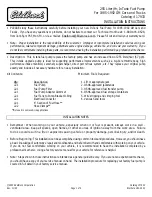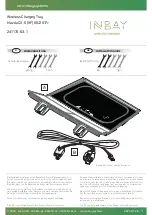
5. Turn the power system on. Keep the power system on while injecting
sealant and air.
6. Turn the selector switch to REPAIR (for U.S. models) or SEALANT/AIR or
PRODUIT ANTIFUITE/AIR (for Canadian models).
7. Press the inflator switch to turn on the compressor. The compressor
starts injecting sealant and air into the tire. When the sealant injection is
complete continue to add air.
8. Models with 215/55R16 93V tires: After the air pressure reaches front: 35
psi (240 kPa)/rear: 33 psi (230 kPa), turn off the kit. To check the pressure,
occasionally turn off the compressor and read the gauge.
9. Models with215/50R17 91H tires: After the air pressure reaches front: 35
psi (240 kPa) rear: 32 psi (220 kPa), turn off the kit.
10. Unplug the power plug from the accessory power socket.
11. Unscrew the sealant/air hose from the tire valve stem. Reinstall the
valve cap.
12. Press the pressure relief button until the gauge returns to 0 psi (0 kPa).
13. Apply the repair notification label to the flat surface of the wheel. The
wheel surface must be clean to ensure the label adheres properly.
Do not operate the temporary tire repair kit compressor for more than 15
minutes. The compressor can overheat and become permanently damaged.
Tire sealant contains substances that are harmful and can be fatal if
swallowed.
If accidentally swallowed, do not induce vomiting.
Drink plenty of water and get medical attention immediately.
For skin or eye contact, flush with cool water and get medical attention if
necessary.
Running the engine with the vehicle in an enclosed or even partly enclosed
area can cause a rapid build-up of toxic carbon monoxide.
Breathing this colorless, odorless gas can cause unconsciousness and
even death.
Only run the engine to power the air compressor with the vehicle outdoors.
HANDLING THE UNEXPECTED
138 |
Changing a Tire
If a tire goes flat while driving, grasp the steering wheel firmly and brake
gradually to reduce speed. Then stop in a safe place.
Replace the flat tire with the compact spare tire
*1
.
Go to a dealer as soon as possible to have the full-size tire repaired or replaced.
When driving with the compact spare on the vehicle, indicators that certain
vehicle features are not working properly may appear on the dash. If these
indicators remain on after the tire is replaced with the correct specified regular
tire, have your vehicle checked by a dealer.
n
Getting Ready to Change the Tire
*1
1. Park the vehicle on firm, level, non-slippery surface and set the parking
brake.
2. Put the transmission into Park (P).
3. Turn on the hazard warning lights and set the power mode to VEHICLE
OFF (LOCK).
4. Open the trunk floor lid.
*1 - If equipped
HANDLING THE UNEXPECTED
| 139
















































